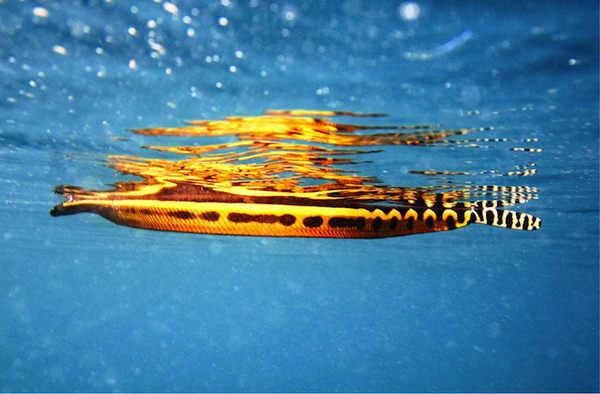Sea Snake Dries to a Crisp Before Rehydrating
A yellow-bellied sea snake viewed from under water.
Scientists have discovered a sea snake that dehydrates for several months before reconstituting itself after heavy rains, according to a new study.
The sea snake, called Hydrophis platurus or the yellow-bellied sea snake, is described in the latest issue of the Proceedings of the Royal Society B. It lives in the salty seawater of the eastern Pacific Ocean and would seemingly become pickled, but several things can protect it from saltwater damage.
“Survival depends on a high tolerance to dehydration, slow rates of water loss in seawater, a capacity to eliminate some amount of excess salts because of salt glands these animals possess in addition to the kidney, and the skin is not permeable to sodium, so no update occurs via this route,” lead author Harvey Lillywhite told Discovery News.
Lillywhite, a professor of biology at the University of Florida, added that, while the snakes drink freshwater, they wind up ingesting a lot of salt from eating fish and from swallowing seawater while gulping down their fish prey.
Lillywhite and his team studied a population of yellow-bellied sea snakes inhabiting the Gulf of Papagayo located off of northwestern Guancaste, Costa Rica.
After bringing the snakes to a lab, the scientists determined that the snakes could tolerate an incredible amount of dehydration. In the wild, the snakes remain in this state for six to seven months at a time.
Snakes captured following seasonal periods of heavy rainfall, however, were properly plumped up with water.
The snakes spend most of their time at various levels in the water column, coming to the surface periodically to breathe. The researchers suspect that the snakes also come to the surface after heavy rains. There, they likely drink the freshwater that accumulates for a short while on the ocean’s surface.
When drinking, snakes do not lap. “The snake simply gulps water and then closes the mouth while water is forced into the stomach,” Lillywhite explained.
Seasonal changes are therefore a life or death matter for these snakes. Unfortunately, some sea snakes have experienced population declines or have even gone extinct due to prolonged drought. This has, for example, happened in some areas off of northern Australia.
Climate change models suggest that areas of drought in the tropics could expand or intensify in the future.
“We cannot do anything about this except to enact measures to combat climatic changes attributable to human enhancement (such as when we burn fossil fuels),” Lillywhite said, adding that oil exploration is also threatening sea snake and other marine life habitat.
He continued, “We could take measures to protect coastal areas where sea snakes are presently abundant because of locally heavy rainfall.”
Harold Heatwole is another sea snake expert. He is a professor of zoology at North Carolina State University.
Heatwole told Discovery News that he agrees with the new findings. He said that some sea snake species, like the one in the study, “require freshwater to drink, as their salt gland cannot keep pace with their salt load. None have been found to be able to drink sea water to hydrate themselves.”
It’s no wonder then that the snakes voraciously gulp water after major storms. They’ve been thirsty for over half a year.(Mar 18, 2014 09:00 PM ET // by Jennifer Viegas)












